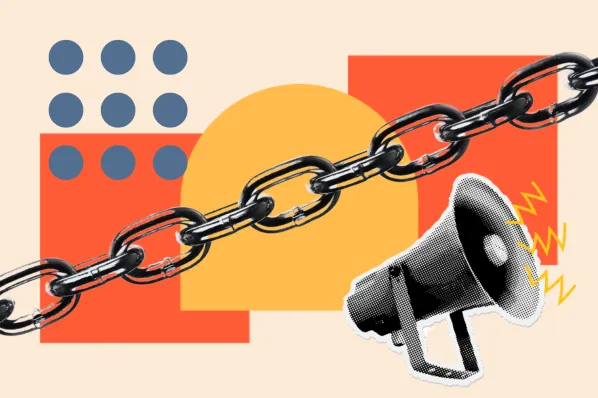Great content and attracting inbound links are major elements of your SEO strategy.
If you’ve created an exciting blog post or ebook, you’ll naturally want to work on making sure that you are driving as much traffic to it as possible. Part of that strategy should always include internal linking, and understanding how the other pages of your website can contribute value toward your new page.
Access Now: 21 SEO Myths to Leave Behind in 2021
If you're working on any important campaign, it’s absolutely critical to figure out which of your already great, high-authority pages should be linking to your new page, or what ongoing efforts can continue to build link authority for your site over time. This process is called internal linking.
What is Internal Linking?
Internal linking is when you use hyperlinks to link one page on your site to another page on your website. This strategy can both keep users on your site longer while boosting SEO authority.
With great internal linking, ranking for very difficult keyword phrases is made much easier as you share the authority of your other best content with your new efforts.
Why Internal Linking Is Important
Remember that a search engine’s ultimate goal is to surface the very best few pages about a topic on the web. With the focus that most linkbuilders and SEO specialists have on inbound links and developing links from other sites, it is easy to overlook how internal linking is important.
Internal Linking and SEO
Each time you create an internal link for a page, it signals to Google that a page on your website is more important. Internal links and links from high-quality outside sources can improve your search engine authority and improve your rankings.
While it’s obviously better to have more people than just yourself voting for your content, if you don’t start by voting for yourself, the search engines will have a difficult time considering your page as one of the best on the web. Internal links are valuable not just because they are a direct signal that your content is important, but also because those links themselves pass on their own link authority.

When you consider that the link authority of each page is being shared into your website from these internal links, the value of your blog and other linked pages is more obvious to search engines.
While these pages are ranking well and bringing traffic into your website on their own, there is a second layer of SEO benefit that they can bring to your website if you properly apply them to your internal linking strategy.
How to Establish an Internal Link Structure
If there’s a page on your website that you care about a lot and that has a lot of value to you, you should be thinking about how you can explain that value to a search engine. One quick way to do this is by creating an internal linking strategy around it.
Start by considering how a search engine understands the value of an internal link; it’s looking at how many pages on your website link to that page, and how they link to it. If every page of your website links to something, it must be important to you -- like your homepage, or your blog’s homepage.
If the only links in to your blog are from your 'About Us' section and nothing from your homepage or your website’s main navigation, you have already sent a strong signal to search engines that your blog is not very strong.
On the other hand, if your blog is in the main navigation on your website, Google and Bing will treat it like one of your top pages.
This works similarly to specific blog posts, as well as your blog. If you write an extensive blog post that defines something, such as a strategy or trend in your industry, you can link phrases in follow-up blog posts to it to prove to Google that this page is valuable to your readers.
To leverage internal linking to the fullest, do an audit of your website's main pages and where you can interlink between them. As you write blog posts, you can also have your writers and others publishing on your website to interlink to your other blog posts and pages when it feels natural.
To help you further develop your internal linking structure, check out the tips below.
3 Ways to Improve the Internal Linking on Your Website
Here are three exercises you should go through to ensure you are effectively using the authority of your internal pages.
1. Sketch out a map of your website.
Make a list of each page in your main navigation and what links are on each of those major pages. This will help you understand the links that you already have between each section of your site, and how you’ve linked it together in the past. Sometimes, laying out your whole website visually is the only way to understand what you’ve overlooked and what’s working. You might just uncover that the reason some of your best pages are ranking well is because you subconsciously did a great job building your own links into them from your other content.
2. Look at the topics that you frequently write about.
If you’re writing regularly about something, you should have another dedicated page on your website about that topic -- like a landing page with an offer, for example. Each of those posts should be linking to that authoritative page on the subject, and it should be optimized for conversions. If your landing page has a prominent call-to-action, your effective use of internal linking will help drive more new leads through the offer.
Also consider where that page lies in your navigation, and if it’s worth linking to from your homepage or products page. Depending on your business, you might even find that linking to a specific blog post or page from your website’s main navigation might suit you well. For example, if your company often needs to explain your business to people who discover you, that would make a good blog post that deserves major promotion across your site.
3. Think about every other page that could link to your ranking page.
If it is a page related to a topic you frequently blog about, make sure each of your new blog posts about that topic reference that page and link into it. You can see this in how HubSpot ranks for the term ' how to use facebook for business.'

One of the major factors behind its rank is that we regularly write about how to use Facebook for Business, we have a lot of very powerful links from our blog posts about using Facebook for business, and we have at least one link in each of those entries to our Facebook for Business landing page. Those blog posts we wrote over the last five years about this topic all have great authority of their own because people have linked to them, and each of them links to our landing page to further build that value.
Editor's Note: The blog post was originally published in Feb. 2012, but was updated in March of 2020 for comprehensiveness and freshness.

Link Building



.jpg)







![How to Find & Add Nofollow Links to Your Website [Step by Step]](https://53.fs1.hubspotusercontent-na1.net/hubfs/53/how-to-add-nofollow-links.jpg)